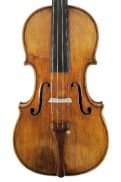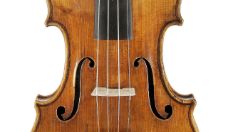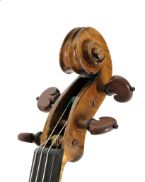Violin, Antonio Stradivari, Cremona, 1725, “Chaconne”
Printed label: “Antonius Stradiuarius Cremonensis / Faciebat Anno 1725” (25 handwritten)The printed label indicates that this violin is a work from Stradivari’s late period, as the master luthier was already over 80 years old in 1725. His productive power remained unbroken, and these late instruments had the same excellent acoustics as his earlier work. Yet his less steady hand shows in the execution of certain details, such as the curves of the f-hole eyes. The contours of the violin known as the “Chaconne” corresponds to the inner mold lettered “B” (Museo del Violino, Cremona, inventory no. MS 38). This form is dated December 6, 1692. Stradivari used two inner molds with the designation “B” whose total length differs minimally. Both are rather short with very broad chests. Stradivari continued to use this model throughout his career. The two halves of the belly have medium-fine grain and are from the same log, and the youngest tree ring is dated 1715. A dendrochronological analysis shows a high degree of correspondence with other instruments Stradivari built in the mid-1720s. Presumably, the wood for these instruments was taken from the same log. A conspicuous knot is embedded on the bass side of the belly. The divided, quarter-cut back displays attractive flames descending slightly toward the edge. A small, lenticular piece of wood was inserted at the center joint of the lower bouts, presumably to correct a flaw when the violin was made. The ribs, pegbox and scroll show flames similar to those of the back. The f-holes are positioned upright, making the instrument very broad in the chest. The f-hole on the bass side is marginally longer, so that the instrument shows a very individual asymmetry. Its fluting is also less regular than in earlier instruments. The robust-looking edges of the belly and back are typical of Stradivari’s late period style. The turns of the scroll are regular, the volutes cleanly smoothed. A wide, blackened chamfer accentuates their contours.
Whereas many Stradivari violins are named for famous previous owners or musicians, this violin from 1725 is named after a composition – the final movement from Bach’s Partita No. 2 for solo violin. A letter from Philipp Hammig to Fridolin Hamma on the occasion of the instrument’s sale to Fridolin Hamma in 1953 provides details about the violin’s history: It was reputedly bought by a German university professor in France in 1866. This professor was acquainted with Joseph Joachim, who repeatedly played it. As the Stradivari appears to have been especially suited to interpreting Bach’s Chaconne, it was given this name, and it has remained the “Chaconne” to this day. Philip Hammig acquired the violin in 1920 and kept it in his private collection until 1954. Later sales were handled by Fridolin Hamma and Henry Werro. A patron of the arts purchased the violin and lent it to Norbert Brainin, the first violinist of the Amadeus Quartet. Brainin ultimately purchased the violin himself and played it until the quartet disbanded in 1987.






